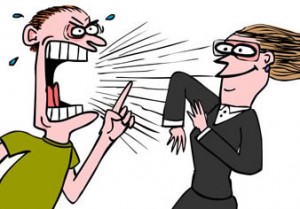 Last week I discussed findings that were released in the American Express Global Customer Service Barometer, a survey conducted in the U.S. and eleven other countries exploring attitudes and preferences toward customer service.
Last week I discussed findings that were released in the American Express Global Customer Service Barometer, a survey conducted in the U.S. and eleven other countries exploring attitudes and preferences toward customer service.
Perhaps the most significant revelation of this survey is that customers are willing to pay more, up to 9% more, to ensure that they obtain superior customer care.
What’s more, the survey revealed that customer service strongly impacts the consumer’s future spending decisions. Not surprisingly, 81% of customers are very likely to repeat business after receiving positive service. Equally as important, 52% of consumers said that they would not patronize a business after a negative experience. Clearly, wonderful service keeps them coming back for more!
I was AMAZED by the other side of these facts because they mean that:
- 19% of customers don’t care how you treat them – I can’t even believe these people.
- 48% are forgiving enough to return after a negative customer service experience.
- 50% reported it takes two poor service experiences before they stop doing business with a company.
Wow. I know how hard we all work to do everything right the first time. But it is great to know that if you make a mistake and screw up – you get a second chance. Customers will extend grace to you.
The study went on to say that companies who get it wrong should realize that there is a cost though. Beyond resolving the problem, customers expect something in return. There are two things that most customers (70%) want when they have had a bad experience.
The first is an apology. This is imperative to making a bad situation good. People want someone to look them in the eye, accept responsibility for the mistake and say, “I am sorry.” It doesn’t matter if it WASN’T THEIR FAULT. It isn’t about you or your employee. It is about the customer. A customer wants to be acknowledged for their negative experience – and that they shouldn’t have had to experience it. Isn’t that what every human wants?
Customers also want some form of reimbursement. When combined with a genuine heartfelt apology, it will cost you much less than you think.
Knowing that someone sees, understands and acknowledges your pain really helps to alleviate that pain. The main point is that the focus is on the customer and their feelings. It does not matter how insignificant the situation may appear to be to you. It does not matter if it wasn’t your fault. It does not matter if the entire situation happened because a vendor screwed up.
It only matters that the customer is upset and you have an opportunity to look like a hero now. And they will tell their friends about how great this experience turned out.
Your Assignment:
I wanted to discuss this topic because you will have to deal with at least ONE UNHAPPY CUSTOMER in your retail career. It is best to prepare and train for it before it happens. Take the following steps to make sure that you have handled this well in advance.
1. Have all your employees read this article.
2. Be sure that every employee practices looking each other in the eye and sincerely saying, “I am sorry.” No mumbling. Say it clearly and distinctly. Repeat it again.
3. Tell them again and again and again that it is about HOW the customer feels – not about whose fault it is. I repeat, “It is NEVER about whose fault it is.” Say that again. Say that 100 times so that it is engraved into their brains.
4. Decide now what employees can offer a unhappy customer. A good rule of thumb is to allow them to give up to 20% of the value of the situation back to the customer in the form of a gift certificate.
5. THIS IS THE DIAMOND IDEA THAT WILL MAKE YOU SHINE ABOVE ALL OTHERS. Give your staff the authority to compensate the unhappy customer immediately without having to talk to anyone else. Imagine how you would feel if that happened to you! Now, imagine being told, “Well, I have to talk to the manager and they are overseas for 3 months but as soon as they get back, I’ll have them call you….” You get the picture, don’t you?
6. Trust your employee to do what it takes to keep the customer. We now know that they can and that the customer will be back.
© RETAILMavens.inc All Rights Reserved.

